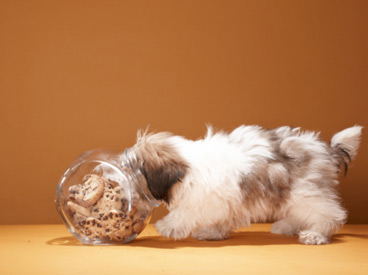Weight loss ranks high on the list of New Year’s resolutions. But while people may recognize that their clothing has become too snug and they should reduce, pet owners often have a hard time seeing that their pet’s girth has also expanded unacceptably.
Pet obesity is a growing problem that often isn’t taken seriously, even though it contributes to life-threatening and life-shortening conditions such as cancer, heart disease, joint problems, and more.
Kim Knap, a certified veterinary technician and a certified canine rehabilitation practitioner, runs the Companion Animal Rehabilitation clinic at the University of Illinois Veterinary Teaching Hospital in Urbana. Through a program called “Shape up, Pup!” Knap works with pet owners to develop practical, individualized plans to safely achieve and maintain ideal body weight for pets.
If you are uncertain whether your pet may have a weight problem, Knap offers these guidelines: “You should be able to easily feel the ribs without a layer of fat. When you look down at your pet, you should be able to see a waist, and when you look from the side, you should see a tucked abdomen,” she says.
But what if Fluffy is, well, fluffy?
“For pets with lots of fur, run your hands through the fur to see if you can easily feel her ribs,” says Knap.
If you think your pet’s weight may be a problem, call this to the attention of your veterinarian. If the veterinarian rules out metabolic disorders, you may be referred to a rehab program like “Shape up, Pup!” that would create a personalized plan to fit you and your pet. These programs often have special equipment, such as a doggy treadmill, that will make exercise more fun for your pet. You will find plenty of options and people who can help once you start looking.
Knap cautions that unmonitored treats are a common pitfall in an otherwise well-regulated pet diet.
“Commercial treats are typically high in calories,” says Knap, “and the semi-moist variety is especially bad. Moist treats add fats and sugars to keep them moist.”
What should you do if your pet habitually looks at you with big sad eyes and begs for treats? Knap says he may really just be begging for your attention and playtime. Try finding more time to play, she advises, which provides both the attention he craves and the activity he needs.
Another approach Knap recommends is to replace calorie-laden treats with baby carrots or ice cubes, inexpensive choices that your pet will love. Most dogs will be just as thrilled about getting that carrot piece and your attention as getting a processed commercial treat. And you might enjoy watching your pet dash after the slippery ice cube just as much as your pet likes chasing it.
Keeping pets at an ideal weight helps them live longer, healthier lives. Fit pets can make the most of play time without tuckering out early, and they are less likely to develop chronic, life-threatening diseases.
For more information about your pet’s ideal weight, talk to your local veterinarian.
Andrea Lin is an Information Specialist at University of Illinois’ College of Veterinary Medicine.
Become a Saturday Evening Post member and enjoy unlimited access. Subscribe now



